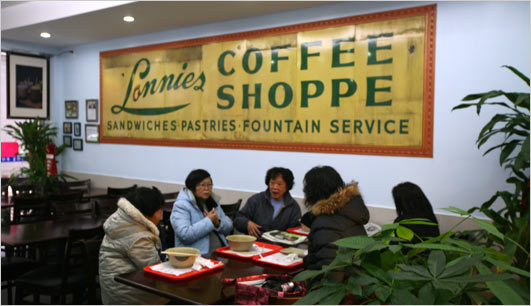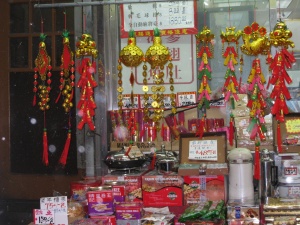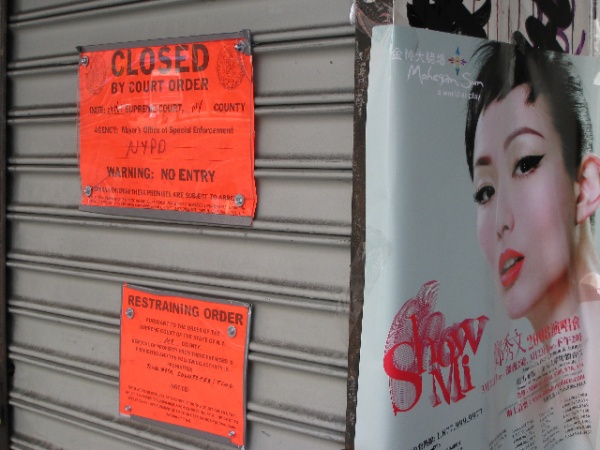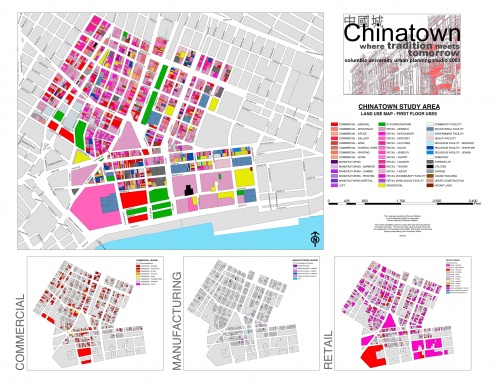From The Peopling of New York City
Business and Economy in Chinatown Since 9/11

Women dining in coffee shop in Chinatown that is otherwise empty
Although the garment industries had already been suffering for various reasons such as outsourcing, after September 11th things went “from bad to worse”(1). Let’s explore what this means. Before September 11th, 56,00 Asians lived in Chinatown, there were 240 garment factories, which employed 14,000 people (30% of whom walked to work). One year after September 11th, 75 shops had closed, unemploying 3,500 garment workers. The total weekly wages of all the garment workers in Chinatown were estimated to have dropped for $3.5 million to $2.51 million. Many of the garment workers would shop and buy food in Chinatown while walking to and from work, or while on their lunch breaks. The loss of jobs in Chinatown had a ripple effect on community businesses and services, such as restaurants, banks, hair salons and clothing stores (1).

The wares of a tourist shop
The number of consumers in Chinatown also decreased because tourists were discouraged from going to Chinatown (unintentionally) by the extra security measures that were put in place. Streets like Park Row were closed off to vehicles, parking spaces were eliminated because of added police presence, a major parking garage was closed, and the streets were more congested than before because of vehicles that were redirected onto those streets. Many tourists and shoppers decided to go visit other places in city that were more convenient. This second loss of a main source of consumers of Chinatown, injured its economy even more. Inevitably, storeowners stocked fewer goods because they now had fewer customers, and this further perpetuated the decrease in costumers, who could not always find the items they were looking for now in the stores of Chinatown (1).
Most recently, this past February, Mayor Bloomberg and Police Commissioner Kelly raided dozens of stores in Chinatown and issued a temporary restraining order to close them down. This has also had a negative impact on one of the main shopping and tourist areas in Chinatown. Visitors now come to the "Counterfeit Triangle" (Canal Street, Walker Street and Centre Street) only to find orange signs announcing their favorite store's closing (as seen in photo below) (2).

Closure Notices Courtesy of Mayor Bloomberg. A once busy street feeling the effects of the closure of the "Counterfeit Triangle."
This latest development certainly has not helped the economic situation in Chinatown. A New York Times report in 2002 brought statistics that showed that 10% of jobs lost after September 11th were from Chinatown alone! (3). "We're in what I would call survival mode," a Chinatown shopkeeper said (4). The economy of Chinatown remains crippled and there don't seem to be major developments towards moving chinatown in the right direction economically. The truth is many housing developers seem to think that the next big thing for Chinatown should be luxury condos. Gentrification is a way to bring life back to Chinatown. Certainly, one does not normally think of luxury condominiums as a staple of Chinatown, but a few years doen the road it may very well be! Perhaps the only way to save Chinatown's economy at this point is to make it the kind of place where real Prada bags can be sold, and not just the counterfeit ones.
There is a darker side to gentrification as well. Although changing the face of the neighborhood is an excellent way to revive it, one could begin to question what might happen to the appeal of such a place and if it can still authentically be Chinatown, because the gentrified buildings are advertising to a completely different population than the one that currently inhabits their streets. Can the demographics of Chinatown change and still remain truly Chinatown? Many would love to see a hipper, hotter, more upper-class Chinatown, but the current residents cannot afford it. Meanwhile, their businesses are closing, and no one seems to be offering an alternative plan for fixing the broken economy of Chinatown.
This is one of the many faces of the changing fortunes of Chinatown.

Urban planning: Layout of buildings and what they're used for
Cited Works:
(1) Chin, Margaret M. “Moving On: Chinese Garment Workers After 9/11.” Wounded City 2005: 188-191.
(2) NYTimes Feb. 26, 2008 City Raids ‘Counterfeit Triangle,’ Shutting 32 Storefronts.
(3) NYTimes April 5 2002 Report Says 10 Percent of Jobs Lost Post-Sept. 11 Were in Chinatown
(4) NYTimes Feb. 26, 2006 Gridlock: The Movie